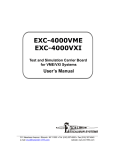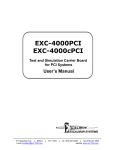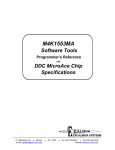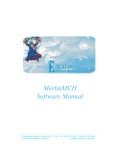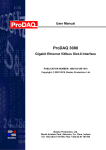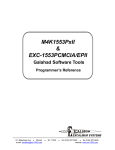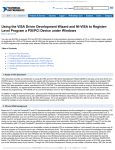Download an Installation Guide
Transcript
Getting Started Installation Instructions for Excalibur Carrier Boards, PCMCIA Cards and Software Tools Welcome to Excalibur Systems suite of boards, modules, PCMCIA cards and software drivers. This document describes how to install Excalibur hardware and software, and contains the following sections: Getting Started ................................................................................................................. 1 Supported Carrier Boards and PCMCIA Cards................................................................................. 1 Supported Operating Systems .......................................................................................................... 2 Installation Instructions for PCI Boards and PCMCIA Cards....................................... 2 Hardware Installation for PCI Carrier Boards and PCMCIA Cards ................................................... Verifying Board/Card Installation....................................................................................................... Software Installation for PCI Boards and PCMCIA Cards................................................................. Running a Test Program ................................................................................................................... 2 3 4 6 Installation Instruction for EXC-4000VME and EXC-4000VXI Boards on a PCI-MXI-2 System .................................................................................................... 6 Hardware Installation for VME/VXI Carrier Boards ........................................................................... Software Installation for VME/VXI Carrier Boards............................................................................. Verifying VME/VXI User Window Size .............................................................................................. Viewing Global Module Information Registers (for Windows 2000/XP) ............................................ 6 7 7 8 Multiple Board Support ................................................................................................... 9 Using Multiple PCI Family Boards................................................................................................... 10 Using Multiple VME/VXI Family Boards .......................................................................................... 11 Troubleshooting............................................................................................................. 13 Getting Started The Excalibur Installation CD contains: • • • • All hardware support files required for the installation of Excalibur carrier boards and PCMCIA cards A setup program to install Excalibur's Software Tools for Windows operating systems; Software Tools for other operating systems may be available on our website www.mil-1553.com The User’s Manual for your specific hardware and a complete Programmer’s Reference for your specific set of software drivers Excalibur’s Products Catalog Supported Carrier Boards and PCMCIA Cards This document describes how to install Excalibur hardware and software for all [c]PCI, VME and VXI carrier boards and their modules, and PCMCIA cards: For all PMC boards, and for ISA boards running on Windows 9x/ME/NT4, see the installation instructions in the Programmer’s Reference for your module or board. For ISA boards running on Windows 2000/XP, see the ISA KernelDriver support for Windows 2000.txt file on the root directory of the Excalibur Installation CD. Installation Instructions page 1 Installation Instructions for PCI Boards and PCMCIA Cards Supported Operating Systems This document contains installation instructions for the following Windows operating systems: • • • Windows 9x/ME Windows NT4 Windows 2000/XP/Vista Most Excalibur products support all of these operating systems. Each of these groups has a separate kernel driver that is installed automatically when installing the Software Tools using the Excalibur Installation CD. When upgrading your Software Tools from our website, make sure to select the correct kernel driver software for your operating system. Note: The EXC-1553PCMCIA/Px card requires Windows 2000/XP/Vista. Windows Vista Note Excalibur Software Tools are fully compatible with Windows Vista. However, a difficulty may arise when running the ExcConfig utility due to Microsoft's new User Account Control technology. This technology requires you to specifically request administrative privileges whenever necessary. Administrative privileges are required to run the ExcConfig utility due to registry modifications made by the utility. Therefore, you can no longer run ExcConfig by double-clicking on its icon, nor can you run ExcConfig by choosing it from the Start menu. Attempting either of these options will result in an error message. Instead, right-click on the icon (or menu item) and choose Run as administrator. Installation Instructions for PCI Boards and PCMCIA Cards Warning: Whenever handling an Excalibur board or PCMCIA card, make sure to wear a suitably grounded electrostatic discharge (ESD) wrist strap. Hardware Installation for PCI Carrier Boards and PCMCIA Cards To install an Excalibur carrier board/PCMCIA card: 1. Do one of the following: • For carrier boards: Make sure the computer is turned off. Insert the board into one of the available slots. (For more information see the Installation section in the User’s Manual for the board you are using.) Start your computer and wait until Windows boots up. • For PCMCIA cards: Turn on the computer and wait until the operating system boots up. Insert the PCMCIA card into any PCMCIA slot. When the card is almost all the way in the slot, push firmly but gently, to ensure a firm connection with the computer. Do not force the card into position. 2. For Windows operating systems that support "Plug and Play" (9x, ME, 2000, and XP), a wizard is displayed to help you install your new hardware. When the wizard asks for a disk or CD containing the driver for the board, select the root folder of the CD. The operating system will find the correct file, and install the kernel driver. page 2 Excalibur Systems Installation Instructions for PCI Boards and PCMCIA Cards Note: Windows NT does not automatically recognize new hardware. For Windows NT, continue with Software Installation for PCI Boards and PCMCIA Cards on page 4, reboot your computer, then run a test program (see Running a Test Program on page 6). 3. If the wizard is not displayed, do the following: • For Windows 9x/ME: Right-click My Computer and select Properties. Click the Device Manager tab then double-click Excalibur PCI or PCMCIA Cards. Double-click the Excalibur PCI or PCMCIA Cards, click the Driver tab, then click Update Driver. Follow the Update Device Driver Wizard. • For Windows 2000/XP: Right-click My Computer and select Properties. Click the Hardware tab, then click Device Manager. Double-click Excalibur PCI or PCMCIA Cards. Right-click the Excalibur PCI or PCMCIA Cards and select Update Driver. Follow the Hardware Update Wizard. 4. Insert the Excalibur Installation CD in the CD drive and follow the wizard to install the new hardware. The board installation is complete. 5. If you are prompted to reboot your computer, reboot now. Verifying Board/Card Installation To verify board/card installation: Note: The following instructions do not apply to Windows NT. For Windows NT, to verify installation install the software (see Software Installation for PCI Boards and PCMCIA Cards on page 4), reboot your computer, then run a test program (see Running a Test Program on page 6). 1. Make sure that the Excalibur board/card is in place in the computer. 2. Right-click My Computer and select Properties. The System Properties dialog box is displayed. 3. Do one of the following: • For Windows 9x/ME: In the System Properties dialog box, click the Device Manager tab. • For Windows 2000/XP: In the System Properties dialog box, click the Hardware tab, then click Device Manager. 4. Double-click Excalibur PCI or PCMCIA Cards. 5. Verify that the Excalibur board/card is listed next to a gray diamond-shaped icon. If you see a yellow exclamation point (!) superimposed on the gray diamond or a yellow question mark (?), this indicates that the board/card is not properly installed. In this case: • Verify that there is enough memory available in the system. If not, free up • more memory or IRQs. For Windows 9x/ME: Verify that the computer is Plug and Play compatible. Many computers claim to be “Plug and Play” but are not fully compatible with the Plug and Play specification. See step 3 of Hardware Installation for PCI Carrier Boards and PCMCIA Cards on page 2. Installation Instructions page 3 Installation Instructions for PCI Boards and PCMCIA Cards Software Installation for PCI Boards and PCMCIA Cards To install the Software Tools for your module/card: Note: • • If there is already a previous version of Software Tools for the same module/ card installed on the computer, the new version will overwrite it. However, the software installation works best on a system that does not have any Excalibur products installed on it. Therefore, it is strongly recommended to uninstall the previous version before installing the new version: For Windows 9x/ME/NT, select Start | Settings | Control Panel | Add/Remove Programs. For Windows 2000/XP, select Start | Control Panel | Add or Remove Programs. If you want to save the earlier version, you can choose to install the new version in a different directory when the Excalibur Installation Wizard prompts you for an installation location. 1. Insert the Excalibur Installation CD in the CD drive. A webpage is displayed enabling you to select installation options. 2. Click Install Drivers, Applications, Utilities on the top-left of the webpage (or on the lower part of the webpage). 3. Click the Setup Button icon (or the Setup Button link). 4. If you are asked whether to save or run the file, click Run. A security message may be displayed. 5. Click Run. 6. Follow the on-screen instructions to select the software that matches your product. 7. When an Excalibur product is already installed, the following options are displayed: Option Description Modify When you select Modify, the installation wizard detects all Excalibur software on your computer and then allows you to install/uninstall additional products from the system. Use this option to install new products, or to uninstall products. Select the items that should remain on the system. Deselect those that you want to remove. Note: The Modify option detects only those items installed using this installation program. Repair When you select Repair, the installation wizard detects all Excalibur products that are installed, and reinstalls them without any user interaction. Use this option to repair a possibly faulty installation, or to install the latest released version of all currently installed products on top of the currently installed versions on your system. This is especially useful for installing an updated version of the software. Remove When an Excalibur product is installed, you can select Remove to remove all unmodified Excalibur files from your system. New and modified files remain, and are unaffected. 8. Continue with the Excalibur Installation Wizard. page 4 Excalibur Systems Installation Instructions for PCI Boards and PCMCIA Cards 9. When the Excalibur Configuration Utility (ExcConfig) main screen is displayed, doubleclick the Card Type field. (If the Excalibur Configuration Utility is not displayed automatically, select Start | Programs | Excalibur | ExcConfig Board Setup Utility.) 10. In the Excalibur Configuration Wizard, select the appropriate board/card. 11. Do one of the following: • When using more than one carrier board or PCMCIA card (of the same type), you must select a unique value for each board/card in the Unique ID or Socket Number field. This number must match the DIP switches, jumpers, or the socket number of the board/card. In the remaining fields, leave the Auto values and click Save. Repeat steps 9–11 for each board/card. (For additional information, see Multiple Board Support on page 9.) • When using one carrier board or PCMCIA card, leave all the Auto values and click Save. Note: Make a note of the row number in the Excalibur Configuration Utility assigned to the device. This device number is used as the parameter for the Init_Module function. • For a PCMCIA card running under Windows NT, you cannot use the Auto values. See PCMCIA Configuration Values for Windows NT on page 5. 12. Reboot your computer. For PCMCIA cards, the card must remain in the computer throughout the reboot operation. • The Software Tools are installed. PCMCIA Configuration Values for Windows NT For PCMCIA cards under Windows NT, use the following values in the Excalibur Configuration Wizard: Name of Field Enter the value Type Select the appropriate PCMCIA card. Memory base A 72K area of memory To determine which memory areas are available on your computer: Select Start > Programs > Administrative Tools > Windows NT Diagnostics > Memory. The memory areas currently in use are displayed. Find a 72K block of unused memory. Type the starting address of the unused block in the Memory base field. Interrupts To determine which interrupts are available on your computer, select Start > Programs > Administrative Tools > Windows NT Diagnostics > Resources. You will see which Interrupt Numbers are currently in use. Find a number that is not in use (often 5 or 7), and type that number into the Interrupt field. Sometimes an Interrupt (IRQ) is not listed as “in use”, but is in fact unavailable. You may need to try several IRQs before you find one that is available and allows you to continue working. If you are not using interrupts, it is recommended to leave the Interrupt field undefined. Table A-1: PCMCIA Memory/IRQ Configuration under Windows NT4 Installation Instructions page 5 Installation Instruction for EXC-4000VME and EXC-4000VXI Boards on a PCI-MXI-2 System Running a Test Program The Software Tools for each module/card includes various demo programs to verify that the specific module/card is operating properly. The source code is provided with the demo programs as a guide to develop your own applications using the Software Tools for the module/card. To run a test program: • Select Start | Programs | [Module/Card Name] | [Demo Program Icon]. Installation Instruction for EXC-4000VME and EXC-4000VXI Boards on a PCI-MXI-2 System Hardware Installation for VME/VXI Carrier Boards Warning: Whenever handling an Excalibur board, make sure to wear a suitably grounded electrostatic discharge (ESD) wrist strap. This section explains the procedure for installing the Software Tools for the Excalibur EXC-4000VME/VXI boards under a Windows operating system. Installation of the EXC-4000VME/VXI board on a Windows system is accomplished by determining the board’s logical address, setting the DIP switch on the board, and installing Software Tools. To verify board installation, run the test-programs that are included on the Excalibur Installation CD. All the files needed to run Software Tools on Windows operating systems are on the Excalibur Installation CD. Note: Software Tools for VME/VXI boards were written for VISA standard. To install an EXC-4000VME/VXI board: 1. Ensure the National Instruments PCI-MXI-2 system is installed correctly. 2. Before installing the Excalibur board, it is very important to determine the board’s logical address. The board requires a 1MB area of memory (within A24 or A32 memory space). Choose a logical address (within A16 memory space) that does not conflict with any other devices in your system. The board is set at default address 80H (128 Dec.). Warning: If a logical address is already in use and it is also used for the EXC4000VME/VXI, the board will not function properly. 3. Set the Board Logical Address DIP switch (SW1) according to the logical address chosen. See the section on DIP Switch Settings in the EXC-4000VME/VXI hardware User’s Manual. 4. Turn on your VME/VXI and PC computers. Run the two programs that establish the connection to the VME/VXI (VXIINIT, the hardware initialization program, and Resman, the resources manager program). Note: page 6 Later versions of the National Instruments PCI-MXI-2 may not require running VXIINIT. Excalibur Systems Installation Instruction for EXC-4000VME and EXC-4000VXI Boards on a PCI-MXI-2 System Software Installation for VME/VXI Carrier Boards For software installation, see Software Installation for PCI Boards and PCMCIA Cards on page 4. Verifying VME/VXI User Window Size This section discusses how to verify that there is enough memory (user window size) on the VME/VXI machine for the board (8 MB), and contains the following sections: • Verifying User Window Size for Windows 9x • Verifying User Window Size for Windows NT/2000/XP Note: If there is not enough memory, the board may not work properly. Verifying User Window Size for Windows 9x To verify user window size for Windows 9x: 1. Install NI-VXI VISA for PCI Based MXI-2 Windows 9x (version 2.0). 2. Select Start | Programs | NiVXI | T&M Explorer. The T&M Explorer main screen is displayed. 3. In System view, right-click on PCI-MXI-2 and select Hardware Configuration. The Settings for PCI-MXI-2 dialog box is displayed. 4. 5. 6. 7. Click the PCI tab. In the User window size field, select 8 MB. Click OK. Reboot your computer. Verifying User Window Size for Windows NT/2000/XP To verify user window size for Windows NT/2000/XP: 1. Install NI-VXI_VISA Tools for PCI Based MXI-2 for Windows NT, 2000 and XP (version 3.3) 2. Select Start | Programs | National Instruments | Measurements & Automation. The Measurements & Automation Explorer main screen is displayed. 3. Under Configuration, double-click Devices and Interfaces. All devices and interfaces are displayed. 4. Right-click on VXI Systems 0 (PCI-MXI-2), and select Hardware Configuration. The Settings for PCI-MXI-2 dialog box is displayed. 5. 6. 7. 8. Click the PCI tab. In the User window size field, select 8 MB. Click OK. Reboot your Computer. Installation Instructions page 7 Installation Instruction for EXC-4000VME and EXC-4000VXI Boards on a PCI-MXI-2 System Viewing Global Module Information Registers (for Windows 2000/XP) To view the Global Module Information registers on a VME/VXI board using National Instruments Measurements & Automation Explorer utility (for Windows 2000/ XP): To view a Global Module Information register: 1. Select Start | Programs | National Instruments | Measurements & Automation. The Measurements & Automation Explorer main screen is displayed. 2. Select Tools | NI-VISA | VISA Interactive Control. The VISA Interactive Control dialog box is displayed. 3. Select the View by Connection option button. 4. Find the Excalibur VME/VXI board in the list. You can identify the board by its device number, which is defined by the DIP switch settings on the board. 5. Double-click the Excalibur board. A new dialog box is displayed, with three tabs (Template, Basic IO, Register IO) and several sub-tabs. This dialog box enables you to access the board, read from and write to the A16 & A24/32 spaces. 6. Select the Register IO tab, then select the viMapAddress sub-tab. 7. Under Address Space, select VI_A16_SPACE. 8. Click Execute. In the Map Address field, an address is displayed. This address points to the beginning of the Global Registers area. Make a note of this address. This address can be used in other functions (viPeek, viPoke). 9. Click the viPeek sub-tab. Make sure the address in the Map Address field is the same as the address displayed on the viMapAddress sub-tab. 10. Under Width, select 16-bits. 11. To view the data value in any Global Module Information register, add a hex value to the address displayed in the Map Address field. For example, if the starting address of the Global Registers area is 1232000, add 32 to view the data value in the Module 1 Information area. To view its data value, type 1230032 in the Map Address field. For information on the hex values of the Global Module Information registers, see the section on Board Global Registers in the EXC-4000VME/VXI User’s Manual. 12. Click Execute. The value at this address is displayed in the Data Value field. page 8 Excalibur Systems Multiple Board Support Multiple Board Support 4000 PCI Software Tools support the use of a maximum of one to four modules (for EXC-4000[c]PCI carrier boards) or one to eight modules (for EXC-4000VME/VXI carrier boards) simultaneously. See Table 1-2: Modules per Carrier Board. In addition, you can use multiple boards simultaneously. See: • • Using Multiple PCI Family Boards on page 10 Using Multiple VME/VXI Family Boards on page 11 EXC-4000[c]PCI EXC-4000VME/VXI M4K1553PxII 4 8 M4K1553MCH 4 8 M4K429RTx 4 8 M4KDiscrete 4 8 M4KSerial 4 8 M4KH009 2 4 M4KCAN 4 8 M4K708 4 8 Table 1-2: Note: Modules per Carrier Board The EXC-1553ccVME/Px board comes with up to 16 built-in M4K1553PxIII modules. Installation Instructions page 9 Multiple Board Support Using Multiple PCI Family Boards To use multiple PCI boards: 1. Each board must be set for a unique ID. The ID of a board is set via the SW1 DIP switch. To set the ID of the board set the jumpers as follows: Board ID SW1 Switch contact 1 2 3 4 0 0 0 0 0 1 0 0 0 1 2 0 0 1 0 3 0 0 1 1 Set DIP switch SW1 to a unique ID by setting the switch contacts open or off to represent logic ‘1’; and closed or on to represent logic ‘0’. Note: Although the Unique ID drop down list (in the Excalibur Installation Wizard) displays the values Auto and 0–4, you can type 0–15 in this field, for the Unique ID of the board. 2. In the ExcConfig utility program, create a separate device number for each board. For each board enter the appropriate values in the ExcConfig screen, as described in the table below. page 10 Name of field Enter this value Type Select EXC-4000PCI from the drop-down list Unique ID Set to the unique ID configured above in Step 1 Memory Set to automatic setting Interrupt Setup Set to automatic setting I/O ports Set to automatic setting Excalibur Systems Multiple Board Support Using Multiple VME/VXI Family Boards Support for the use of multiple boards is implemented via the module specific Init_Module function. See the Programmer’s Reference for your module. This section discusses: • • Using Multiple VME/VXI boards on page 11 Using Multiple EXC-1553ccVME/Px Boards on page 12 Using Multiple VME/VXI boards A unique Logical Address must be set for each board. Use DIP switch SW1 to set the board’s Logical Address. Examples of Logical Address Switch (SW1) Settings: MSB Logical Address Switch (SW1) LSB ‘1’ ‘1’ 1 2 3 4 5 6 7 8 A15 A14 A13 A12 A11 A10 A9 A8 A7 A6 Logical Address Switch Settings Hex Dec 1 1 0 0 0 0 0 0 0 1 20 32 0 0 1 0 0 0 0 0 80 128 1 0 0 0 0 0 0 0 81 129 1 0 0 0 0 0 0 1 C0 192 1 1 0 0 0 0 0 0 FF 255 1 1 1 1 1 1 1 1 Example: For a logical address of C0 (H) [=A16 Address F000 (H)], set position 1 and 2 to OFF or Open and all other switches to ON or Closed. Switch ON or Closed = logic 0 at switch position Switch OFF or Open = logic 1 at switch position Note: • • • The numbers in the above table under Switch Settings indicate switch positions. Address lines A15 and A14 are always decoded as ‘1’. Address lines A5–A0 are always decoded as ‘0’. Installation Instructions page 11 Multiple Board Support Using Multiple EXC-1553ccVME/Px Boards A unique Logical Address must be set for each board. Use jumpers JP1–JP8 to set the board’s Logical Address. Examples of Logical Address Jumper (JP1–JP8) Settings: MSB Logical Address Jumpers (JP1–JP8) LSB ‘1’ ‘1’ JP1 JP2 JP3 JP4 JP5 JP6 JP7 JP8 A15 A14 A13 A12 A11 A10 A9 A8 A7 A6 Logical Address Jumper Settings Hex Dec 1 1 0 0 0 0 0 0 0 1 20 32 0 0 1 0 0 0 0 0 80 128 1 0 0 0 0 0 0 0 81 129 1 0 0 0 0 0 0 1 C0 192 1 1 0 0 0 0 0 0 FF 255 1 1 1 1 1 1 1 1 Example: For a logical address of C0 (H) [=A16 Address F000 (H)], short jumpers JP3–JP8, and do not short jumpers JP1 and JP2. Jumper shorted = logic 0 Jumper not shorted = logic 1 Note: • • • page 12 The numbers in the above table under Switch Settings indicate jumper positions. Address lines A15 and A14 are always decoded as ‘1’. Address lines A5–A0 are always decoded as ‘0’. Excalibur Systems Troubleshooting Troubleshooting This section contains troubleshooting information for software installation from the Excalibur Installation CD. 1. If the Excalibur webpage does not open automatically when you insert the Excalibur Installation CD into the CD drive, double-click the CD drive in My Computer, then double-click setup.exe. 2. When the Setup program starts, you may be advised by Setup: "Do you want to install and run setup.exe? The publisher cannot be determined due to the problems below: Authenticode signature not found." The Excalibur CD is made in-house, and is virus free, so there is no risk in running the Setup program. Click Yes, to proceed with setup. 3. When running the installation the first time, you may get a message that the system is installing items such as Windows Messaging, and that the system must now reboot before continuing. This is normal, depending on the current setup of your system. The installation will proceed after rebooting. 4. If you selected MerlinPlus or MerlinMCH, at the end of the installation of the selected Software Tools, the installation wizard will install the Merlin product. Upon completion of the Merlin installation, select the checkbox to Launch the program file. Follow the on-screen instructions: • During Merlin installation, the Borland Database Engine (BDE) is installed, and a configuration file for Merlin is set up. At the end of this screen text, press any key, and the BDE Administrator will run. Select Object | Open Configuration from the menu. • Select the file C:\Program Files\Excalibur\Merlin\merlin.cfg. Close the BDE Administrator, and answer Yes to the question "Use C:\...\merlin.cfg as default configuration?" • See the file readme.txt (in the MerlinPlus or MerlinMCH folder) for other troubleshooting tips. 5. If you receive a system error message "Unknown database, Alias: DevDB_BDE" when you first run a Merlin application, the correct configuration file was not selected in BDE Administrator. Select Control Panel | BDE Administrator | Object | Open Configuration | merlin.cfg from the Merlin folder (C:\Program Files\Excalibur\Merlin), or from the BDE folder (C:\Program Files\Common Files\Borland Shared\BDE). Exit the BDE Administrator and save this as your default configuration. 6. Errors 2711, -1603, 1309: The directory structure for all VxWorks products has been changed. Therefore, when installing any Software Tools with a CD newer than your original installation, the error reports Error 2711, Error -1603 and Error 1309 may occur. Solution: • Write down the Excalibur products installed on your computer. • Run the Excalibur Installation Wizard. See Software Installation for PCI Boards and PCMCIA Cards on page 4. • Select Remove. This removes all unmodified Excalibur files from your system. New and modified files remain, and are unaffected. • Run the Excalibur Installation Wizard again, and select the specific products you want to install. [October, 2007] Installation Instructions page 13













